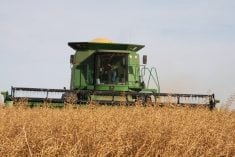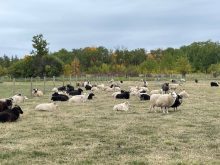Irrigation is often referred to as the “lifeblood” of southern Alberta. Irrigation water was first diverted from the St. Mary River in 1900 and arrived by canal system to Magrath, Raymond and Lethbridge.
Now, 122 years later, just over 1.8 million acres are irrigated in Alberta. Irrigated agriculture contributes about $6.5 billion to Alberta’s GDP and supports about 55,000 full-time jobs.
About 6,000 producers irrigate just over 1.51 million acres within the 12 irrigation districts in southern Alberta. An additional 298,000 acres are irrigated in private projects by about 2,600 farmers.
Read Also

Claas brings 1000 Series SP forage harvesters to Canada
In mid-August, Claas unveiled its new line of Jaguar forage harvesters at an event in Visalia, California, deep in the heart of that state’s dairy region.
Alberta’s climate, soils and water
Southern Alberta has a significant moisture deficit for growing crops. Warm, dry, chinook winds exacerbate the moisture deficit. The average growing season precipitation is in the range of 150 to 175 millimetres (six to seven inches). Most cereal and oilseed crops require 450 to 500 millimetres (18 to 20 inches) of water for optimum production. Crops such as corn, sugar beets and alfalfa need up to 600 to 650 millimetres (24 to 26 inches) of total water for optimum production. Irrigation is critical to alleviate the moisture deficit.
Most of the lands irrigated in southern Alberta are in the Brown and Dark Brown soil zones. The growing season can be up to 150 days, and this has been increasing with climate change. Southern Alberta is one of the sunniest areas in Canada, with warm days and cooler nights. Growing degree days (GDD), a measure of heat, is ideal for irrigated crops.
Soils in much of the irrigated areas of southern Alberta are well suited for irrigation. Initially, gravity (surface flood) irrigation was developed on lacustrine soils (lake-deposited material) and fluvial lacustrine soils (material deposited by slow-moving water). The topography of these lands was reasonably level to gently undulating, making them ideal for development of gravity irrigation. As sprinkler irrigation became more common in the 1960s and 1970s, glacial till-deposited soils, with somewhat more gently rolling topography, were developed for irrigation.
Alberta Agriculture requires land proposed for irrigation development to be classified suitable for irrigation to ensure long-term sustainable production. Strict standards for soil classification suitability examine soil parent material, depth, texture, structure, drainage, salinity, sodicity, pH, erodibility and organic matter content. Other land-rating factors considered include topography, groundwater and depth to bedrock. Land must be classified suitable for irrigation before a water right or water licence can be granted.
The combination of a warm, sunny climate, longer growing season and suitable soils coupled with availability of water for irrigation make southern Alberta ideal for irrigated agricultural production.
Alberta’s irrigation infrastructure
Irrigation in many areas of the world including the U.S. Midwest, depends on groundwater. Alberta’s irrigation water comes mostly from snowmelt from the Rocky Mountains in southern Alberta and northern Montana. Water is stored in three major on-stream dams — the Waterton, St. Mary and Oldman Rivers. Water for irrigation is diverted from the St. Mary, Belly, Waterton, Oldman and Bow Rivers by complex irrigation infrastructure and rechannelled and stored in 45 off-stream storage reservoirs.
Alberta Environment has 339 kilometres of canals for water diversion and delivery water to irrigation districts. The 12 irrigation districts have a total of 7,704 kilometres of canals and pipelines to distribute water to farmers.
Irrigation districts have been very successful in improving water conveyance efficiencies. In the past 35 years, replacement of earth canals with buried pipelines has been a focus. Over 57 per cent of water is now delivered to farmers by buried pipelines, which eliminate seepage and evaporation and do not take land out of production. Soil salinity and waterlogging problems have mostly been eliminated in the irrigation districts with pipelines and rehabilitated canals.
Private irrigation projects draw directly from surface water. Projects vary in size from a few acres to several thousand acres. Each private project has its own water licence regulated by Alberta Environment. The largest private project is on the Blood Reserve with a water licence to irrigate 25,000 acres. Other larger projects include the Willow Creek project, which irrigates 13,000 acres, the Highwood/Little Bow project, irrigating 20,000 acres and the Sheerness/Deadfish diversion project will irrigate up to 16,500 acres.
Each of Alberta’s 12 irrigation districts also have water licences issued by Alberta Environment. The total annual water allocated to all irrigation districts is 2,868,938 acre-feet (see Table 1 below). One acre-foot of water is the amount of water that would cover one acre, one foot deep, which converts to 43,560 cubic feet or 1,233 cubic metres of water.

In 2021, a much drier-than-normal year, the 12 districts diverted a total of 2,200,900 acre-feet of water or 76.9 per cent of their total water licence allotments (see Table 1 above). Of the water diverted by all districts, 78 per cent was used for on-farm irrigation. Of the remaining 22 per cent, about 7 per cent was lost to evaporation from canals and reservoirs, two per cent was lost as seepage, 10 per cent was return flow back to rivers and three per cent was for municipal uses, livestock operations and other uses.
Alberta’s irrigation farmers have dramatically improved on-farm irrigation water efficiency. Prior to the 1970s, about 80 per cent of land was irrigated by gravity (surface flooding) with water application efficiencies in the range of 30 to 65 per cent, depending on the surface method. Significant amounts of water were lost due to deep percolation and runoff from fields and evaporation. Now, only five per cent of land is gravity irrigated in the irrigation districts.
In 2021, 87.4 per cent of land within irrigation districts was pivot irrigated, with 83.1 per cent irrigated by very efficient low-pressure pivots with drop tubes. These systems can have application efficiencies of 80 to 85 per cent. Alberta farmers have invested heavily to improve their water application. Overall, on-farm efficiencies could increase to 85 per cent as new, higher-efficiency sprinkler nozzles and improved irrigation management technologies are adopted by producers.
With substantial improvements to canal distribution infrastructure and on-farm water use efficiencies, the average annual depth of irrigation water diverted to irrigation districts has been reduced from about 600 millimetres in 1985 to less than 300 millimetres. As a result, gross irrigation demand has been dramatically reduced.
The combined water conservation by irrigation districts and farmers over the years has made water available to allow irrigation districts to expand their irrigated land base, without any additional water diversion or allocation.
Commonly grown irrigated crops
There is a wide range of crops grown under irrigation in southern Alberta. A detailed listing of crops and acreages for 2021 is available at Alberta Agriculture Irrigation Information.
The four main categories of crops grown are cereal, forage, oilseed and specialty crops. In 2021, cereal crops were grown on 32.2 per cent of irrigated land with spring wheat, barley and durum wheat making up the three most grown.
Forages made up 32.7 per cent of irrigated acreage, with alfalfa, corn silage and barley silage being most common. Oilseed acreage was 13.5 per cent and canola was the dominant crop grown. High-value specialty crops are grown on 20.9 per cent of land with dry bean, potato, sugar beet and canola seed being the most common.
Economic evaluation of irrigation
An economic evaluation of irrigation within Alberta’s irrigation districts was completed for the Government of Alberta. The study is available online on its website as a PDF.
The study concluded the combination of irrigated crop production, livestock production and food processing contribute 28 per cent of Alberta’s total agri-food GDP. The combined annual sales of irrigated crops and livestock contribute 27 per cent of the total primary agricultural sales in Alberta. The sales of irrigated specialty crops contribute $500 million annually to the Alberta economy. Livestock sales from within the irrigation districts contribute $2.2 billion, representing 38 per cent of Alberta’s total livestock sales.
The study concluded that crop and livestock production from the irrigation districts generate eight times more revenue per hectare than dryland.
Irrigation expansion
In 2021, the Alberta government and Canadian Infrastructure Bank announced plans to invest money to expand irrigation by up to 230,000 acres in eight irrigation districts. The goal is to modernize existing works and build new irrigation infrastructure to increase water use efficiency, irrigated acres and crop production.
The Alberta government and the Municipal District of Acadia and Special Areas region of Alberta are looking at the feasibility of developing a new irrigation system from the Red Deer River in southeastern Alberta. To date, the initial investigation has demonstrated it may be feasible to develop up to 108,000 irrigated acres in the region. The initial study has suggested that land quality and water resources are suitable for irrigation development. The next phase is moving forward to complete preliminary engineering by 2024.
A significant role
Irrigation in Alberta plays a significant role in increasing crop and livestock production. Irrigation water distribution and application efficiencies have improved dramatically over the past 30 to 40 years. In the future, irrigation will likely become even more important as world demand for crops and livestock products continues to increase. In my next column, I will discuss irrigation water management to optimize irrigated crop production.
















